Introduction: The Role of Fiscal Policy in Economic Management
Hello everyone! Welcome to today’s article on the fascinating world of fiscal policy. As we delve into the intricacies of expansionary and contractionary fiscal policies, we’ll explore how governments utilize these tools to steer economies towards stability and growth.
Defining Expansionary Fiscal Policy: Boosting the Economy
Expansionary fiscal policy, as the name suggests, is all about expansion. During periods of economic downturn or recession, governments employ this policy to stimulate economic activity. The primary tools at their disposal are increased government spending and reduced taxation.
The Mechanism: How Expansionary Fiscal Policy Works
When the government increases its spending, it injects more money into the economy. This, in turn, leads to increased demand for goods and services, prompting businesses to produce more. To fund this increased spending, the government may resort to borrowing or printing more money. Additionally, by reducing taxes, individuals and businesses have more disposable income, further fueling consumption and investment.

The Goals: What Expansionary Fiscal Policy Aims to Achieve
Expansionary fiscal policy has two primary objectives. Firstly, it aims to boost aggregate demand, which is the total demand for goods and services in an economy. By doing so, it helps counteract the reduced demand during a recession. Secondly, it strives to create jobs and reduce unemployment, as increased economic activity often translates into more employment opportunities.

Contractionary Fiscal Policy: Tackling Inflation and Overheating
While expansionary fiscal policy is employed during economic downturns, contractionary fiscal policy comes into play when the economy is overheating, and inflation becomes a concern. The primary tools here are reduced government spending and increased taxation.
The Mechanism: How Contractionary Fiscal Policy Works
By reducing government spending, the overall demand in the economy decreases. This can help curb inflationary pressures, as less demand often leads to lower prices. Additionally, by increasing taxes, individuals and businesses have less disposable income, which can further dampen spending and reduce inflationary pressures.
The Goals: What Contractionary Fiscal Policy Aims to Achieve
Contractionary fiscal policy has two primary objectives. Firstly, it aims to control inflation, which is the sustained increase in the general price level of goods and services. By reducing demand, it helps stabilize prices. Secondly, it aims to prevent asset bubbles and speculative behavior, which can lead to economic instability in the long run.
